If you were to come to my house I would, with little shame, ask if you’d like a garden tour. No matter your answer, I would bring you over to my tomatoes and show you how I’m pruning this year, how I still don’t know about the kale or the rosemary, or if the potatoes were a good idea. I would tell you about how the kid next door informed me, over the fence, that his dad thinks my garden doesn’t get enough sunlight, which is correct, but he should tell his dad to mind his own business.
While I’ve already shared my garden’s history and tips for getting your own garden started in my gardening guide (parts one and two), I didn’t share my nitty-gritty, perhaps not-so-interesting garden plan. So come on over, we’re doing a tour.
The Shade
Our backyard is difficult—light is limited, so early spring and fall plantings are a wash, leaving just the summer to garden. Shade-friendly vegetables, meanwhile, are not very interesting to me. The vegetables that do well in shade are usually ones eaten for their leaves, like lettuce, or are cold-tolerant but heat-sensitive, like brassicas (cabbage, cauliflower, broccoli, etc.). There’s so much lettuce in our June and July CSA shares that I can’t get excited about leafy greens, even if they are homegrown, and the cold-loving plants are space-hogging and quick to bolt in the heat of a July garden. This presents me with a situation—namely, what is left to plant?
After some haphazard research, I decided to plant peas, potatoes, echinacea, and nasturtiums in my most shaded bed. A quick Google search told me potatoes would survive in the limited light and I figured flowers would add some much needed color.
Last year was my first planting peas, and it taught me an important lesson: plant early. It’s heartbreaking to get to June and have not a pea to show for it. This year I got closer and sowed on April 15, but still should have planted weeks earlier. We got three sad pea pods before they died off, as expected, in early July. I love the look of the trellis and I’m not sure what to replace the peas with next year. Perhaps sweet peas (toxic to eat, but beautiful and wonderful-smelling)? I would plant cucumbers or pole beans but, again, the shade—either would need more sun than our backyard is able to give.
I planted the potatoes on the same day as the peas, and by June their foliage was out of control. The echinacea, nasturtium, and my hopes for vibrant color are all lost in the mess of green—looking back at the planting instructions, I should have continued “hilling” the potatoes instead of letting them be. The echinacea is a perennial, at least, so I will wait another year for a bloom. I’ll see how I feel about the potatoes once I harvest, but quite obviously, I still don’t know what to do with this bed. Next year—colorful herbs? Low-light pollinator patch? I’ll take your ideas.
The Original Beds, Part I
I am reconsidering my tomato strategy. Because of the shade situation, my tomato plants have tended to grow too quickly in their quest to find more light, leaving the plants long, leggy, and fruit-less on the bottom half of the plant. I prune the top stems off early in the season to prevent the plants from getting too tall and flopping over their extra-tall cages. Despite my loving care, however, my large slicer-tomato plants yield far fewer fruit than the sun-drenched gardens of YouTube.
Out of this year’s six tomato plants, two are heirloom slicers: Cherokee Purple and Goldie. I’ve planted a Cherokee Purple each year of my garden, but this is the first time it’s lived this long. The first year it became infested with what appeared to be hundreds of tiny spiders and I panicked and dumped the whole grow bag in the garbage. Then last year, I mislabeled the seedling and accidentally transplanted two cherry tomato plants. The other slicer is a Goldie, and even though I’ve been saying only cherries here on out, I know next spring I will remember Goldie’s summery orange flesh and plant it again.
In one bed and a grow bag I planted a Sun Gold and Honey Drop cherry tomatoes, and in two small pots I planted Tiny Tims, a dwarf tomato variety that should, allegedly, grow to be only 2 to 3 feet high, but mine grow and grow and grow.
Despite their sun-starved legginess, the cherry tomato plants yield a daily handful of glorious, juicy orbs during the height of the season. I’m tempted, with only 4 to 5 fruits across my two slicer plants, to go all in on cherries next year.
Speaking of, I’m convinced the Sun Gold seeds I purchased from an Etsy shop last year were not Sun Golds at all. This year I traded seeds with my friend Muriel and the fruit both looks and tastes quite different. The Real Sun Golds are nearly salty, full of umami and, when ripe and warm from the sun, maybe the best thing I’ve ever eaten. The trusses are perfect, too, with 8 to 9 perfectly pollinated tomatoes each, whereas both the Fox Cherry I planted in past years and this year’s Honey Drop yielded far fewer.
The other cherry tomatoes and the Tiny Tim are throwaways, to be honest. They are from the same Etsy shop as the Impostor Sun Golds, are far too tall and weak, and are not that flavorful. I may try dwarf tomatoes again next year (perhaps in the GreenStalk?), but certainly from a more trustworthy source.
The Original Beds, Part II
You would think with me going on like this that the tomatoes are the only things in these two beds, but there are also onions, eggplants, peppers, okra, rosemary, chives, parsley, sage, basil, and Celosia flowers, otherwise known as cock’s comb.
I’m not sure what happened to the onions—they’ve been small and floppy from the beginning, and while they haven’t rotted they also haven’t thrived. I grew them from plant starts, so I know maturity wasn’t an issue. Another sunlight problem, maybe?
I’ve yet to see an okra fruit, but the mini Fairy Tale eggplants have thrown off some babies, and the herbs, of course, have flourished. I planted a new basil this year, Dark Opal, which I have loved for the color, plus a few more Genovese basil plants than in years past. I picked up the sage and rosemary from the nursery and will prune them to overwinter for next year.
The peppers have been doing surprisingly well. I’ve had a difficult time growing pepper from seed in the past, but this year the Lemon Drop Pepper plant was furious; at this rate, I’ll get enough to make a fermented hot sauce. The other plant is Aji, also from Muriel, that I impulsively planted. I’m excited to see what it tastes like .
The GreenStalk
The vertical planter has taught me a great deal. My major takeaways: more flowers, more long-lasting flowers, more herbs, and a successive planting plan.
The lettuces, of course, lasted only through the mild weather; I loved the tatsoi and will grow it again but will forget about the brushed oak and arugula, which weren’t worth the effort or space. I thought radicchio would be the answer to my lettuce boredom, but something awful happened to my beautiful heads. I’m not sure if a pest got to it, but it started to rot on the stalk. Heat?
I don’t like the look of nasturtiums for the same reason I don’t like marigolds or zinnias—I find the leaf shape unsatisfying and the blooms are snoozy. I grew them anyway for their edible flowers and to make nasturtium salt, but I got nary a bloom! I learned afterward that nasturtiums, the little devils, don’t like fertile soil. Nevertheless I will be planting them next year, and more of them, because they were an excellent trap plant for aphids.
I transplanted some nursery parsley into the GreenStalk and realized I should have done that earlier. Next year I’ll also plant cilantro as I’d like to grow coriander seeds, so this seems obvious. While I never thought I was a particular fan of oregano, I have been enjoying harvesting, drying the leaves, and crushing them into tomato sauces. I will plant a few more cells next year to have oregano to share.
I also planted strawflowers but didn’t take my own advice and read the packet, so I had 3-foot high stalks coming off the top of the vertical planter. Speaking of flowers, I need more pollinators and more color. I enjoyed the cosmos I planted, but their season was short-lived. If you have suggestions, I would love to hear them.
And then last week I direct-sowed a variety of carrots and radishes into the empty cells in a delusional attempt for a fall garden. It may be too hot for the seeds to germinate outside but a girl can try.
The bags and pots
Last year I planted my summer squash in a bed inside a short tomato trellis, which it quickly grew outgrew and started trellising out and onto the hedges that separate our deck from the backyard. The hedges had a difficult year and didn’t need the additional weight, so instead of using up precious square footage in the raised bed, I planted my summer squash in a large grow bag with the vines trailing along the ground. Letting the squash trail around the beds is a risk to grow along the ground, with pests having easier access and all, but, I have only seen one rat in our backyard and that was in the dead of winter, when it trudged through the snow and peaked in through the backdoor window! There is a vibrant backyard squirrel community, but thankfully they ignore my vegetables and focus their efforts on burying the peanuts they acquire from a well-meaning neighbor. I only have to dig up a handful of sprouting peanuts a season.
The Brown Turkey fig tree was an impulsive Etsy purchase last year. It had a rough start after being transplanted but bounced back, and while it’s still on the small side, it seems healthy. I’ll pot it up into its final home in the fall and store it in our basement again for the winter.
The laurel bay and curry leaf trees had a difficult winter inside under the grow light. The curry leaf has recovered and is thrilled to be living in the subtropical climate of New York City, but the bay hasn’t thrown off any more leaves, which is a bummer because it was so delightful to be able to pick a leaf off my little tree and throw it into a pot of beans last year.
I also impulse purchased chamomile, lemongrass, eucalyptus, mint, thyme, and some flowers I’ve already forgotten the names of from the nursery to throw into the various mini pots around the backyard, and I will overwinter what I can. 🍅
Read more about my garden:
Home Food is edited by Jillian Goodman.

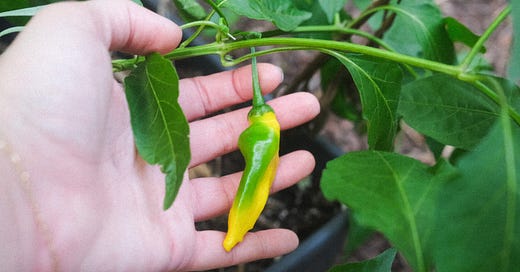

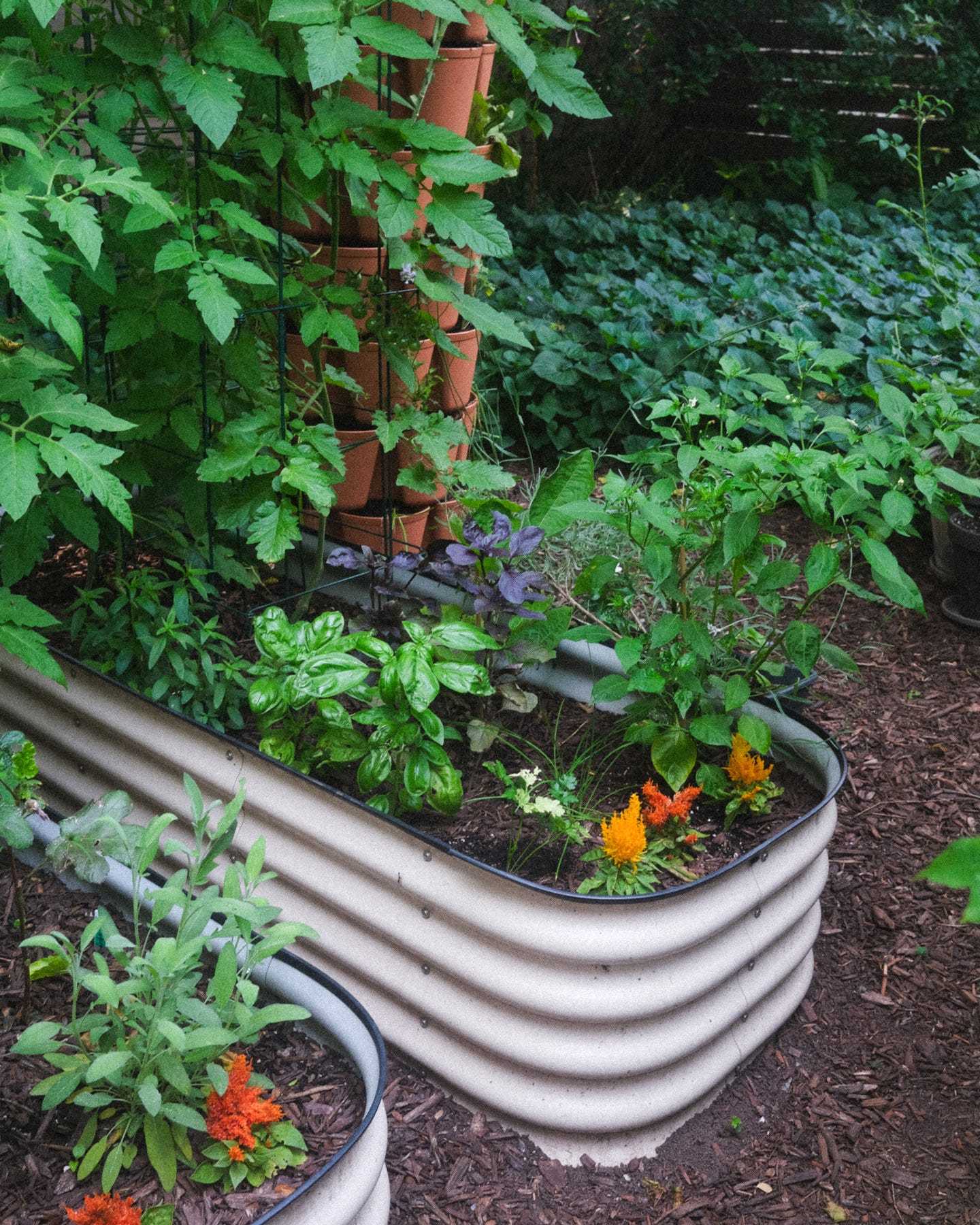
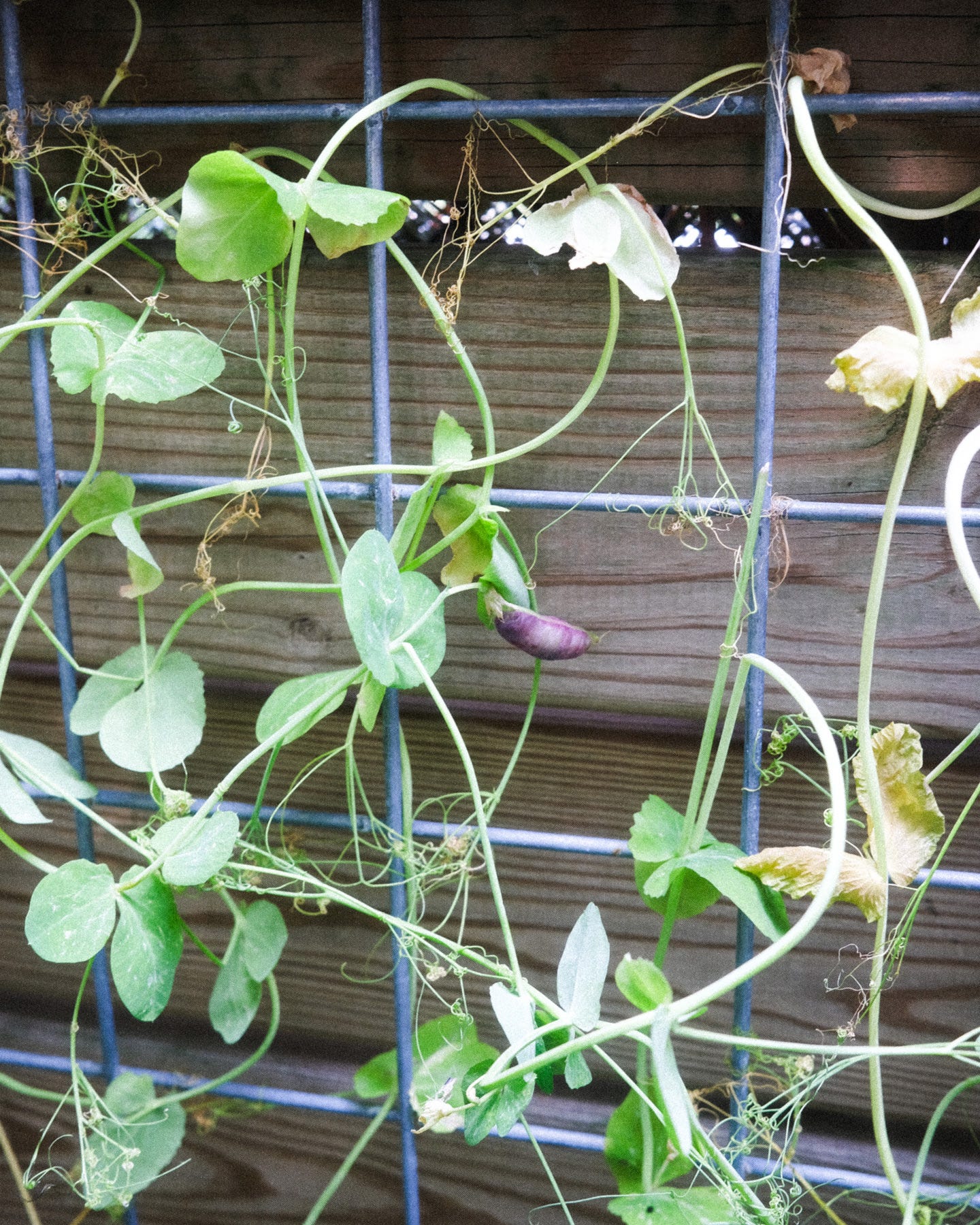
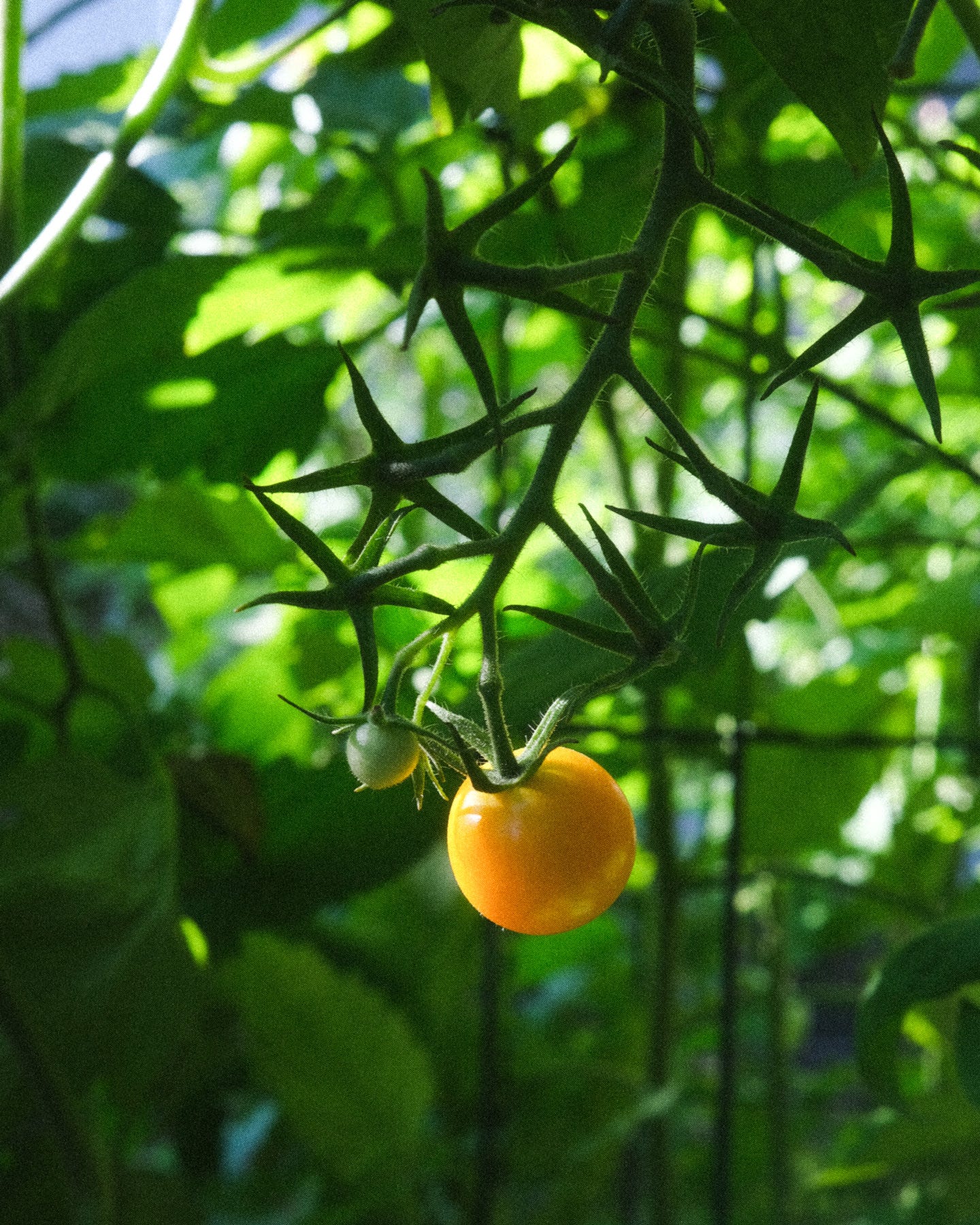
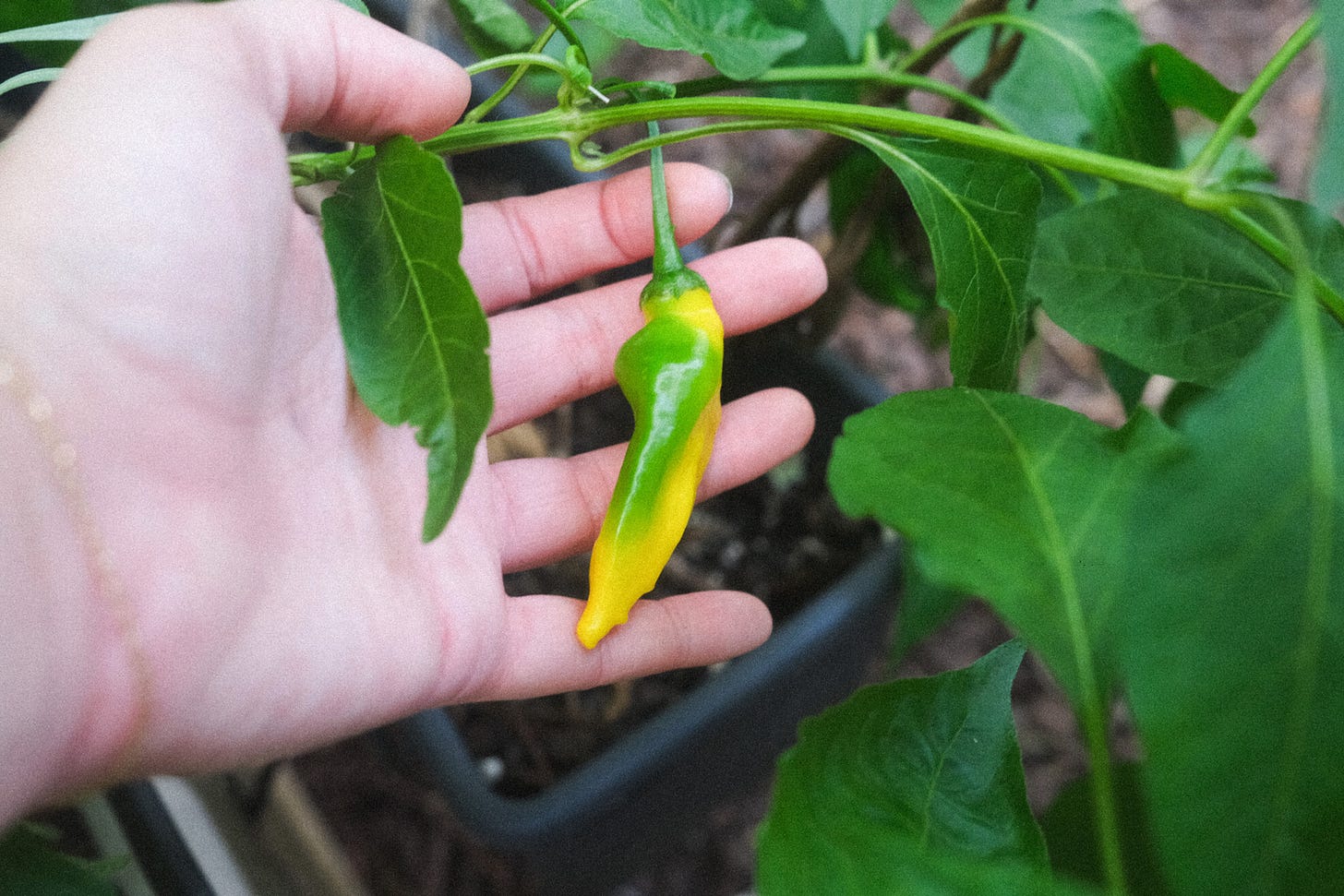
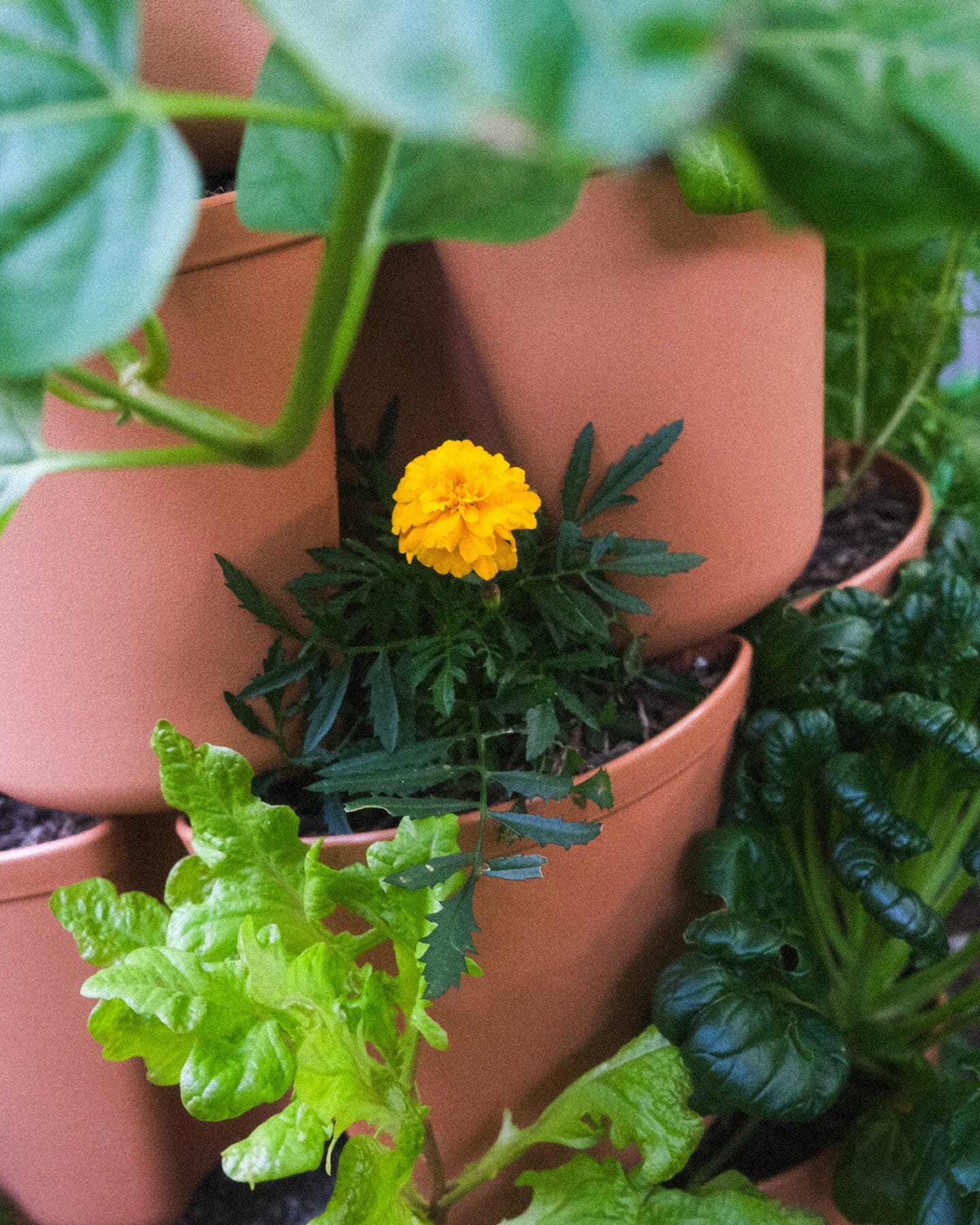
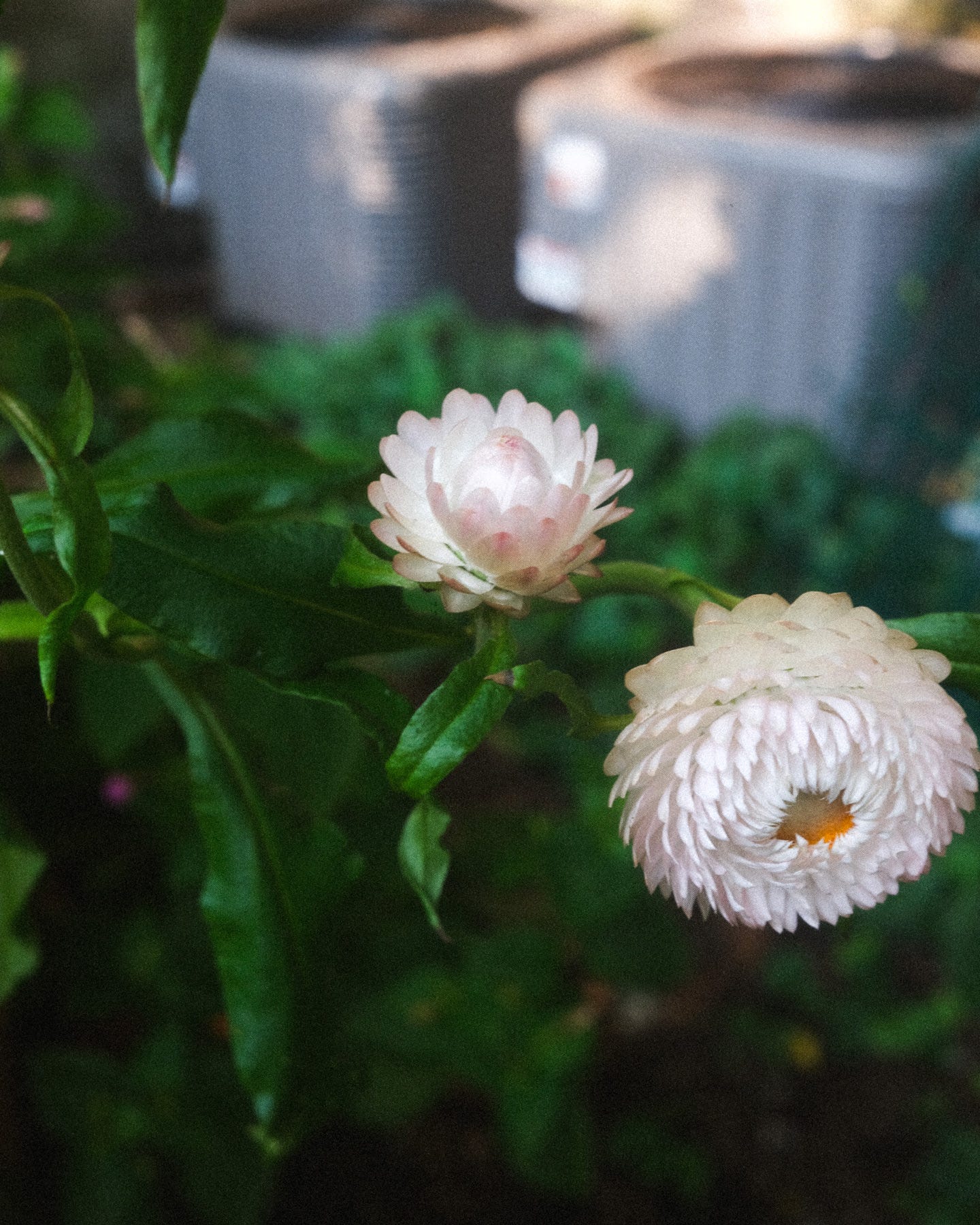
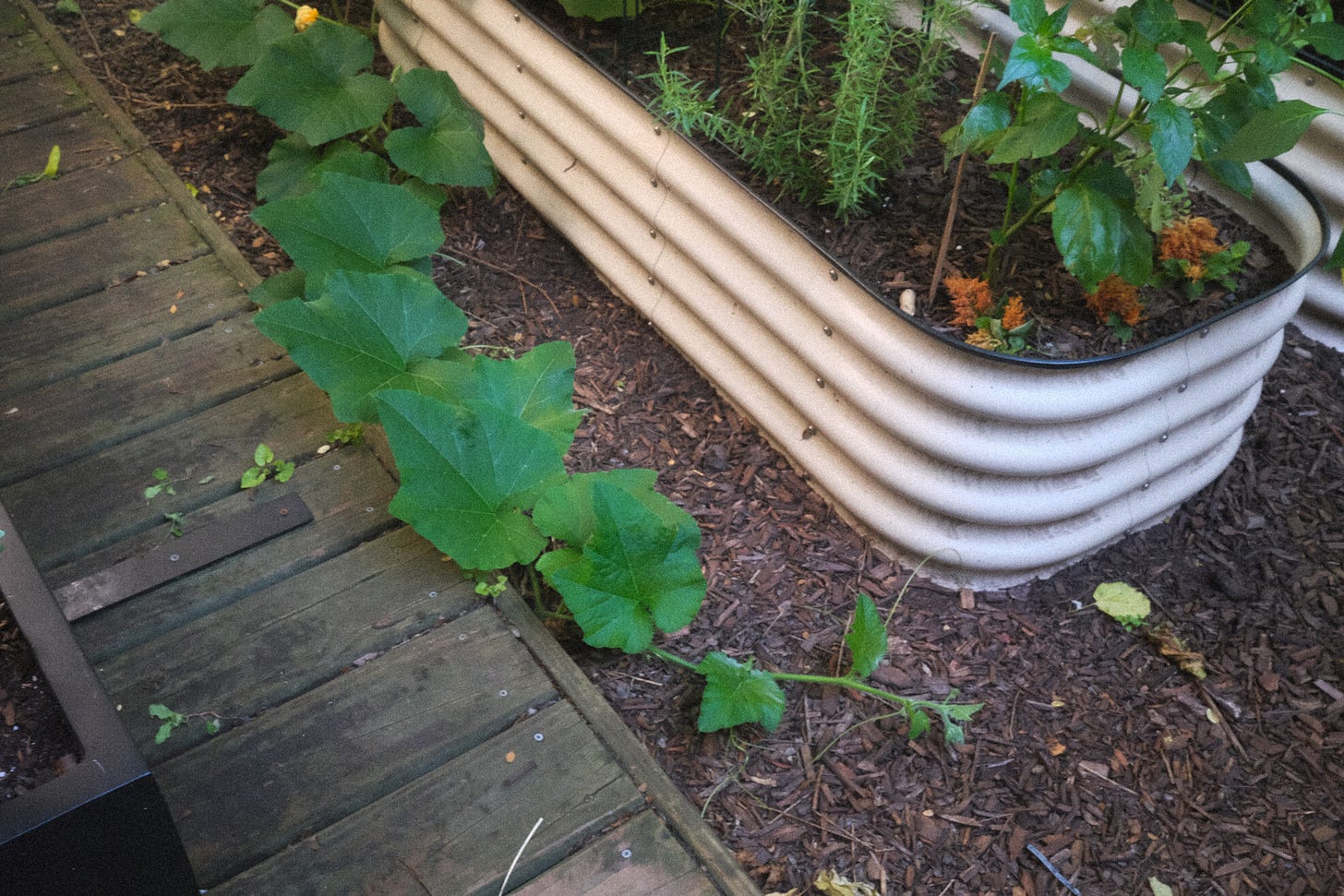
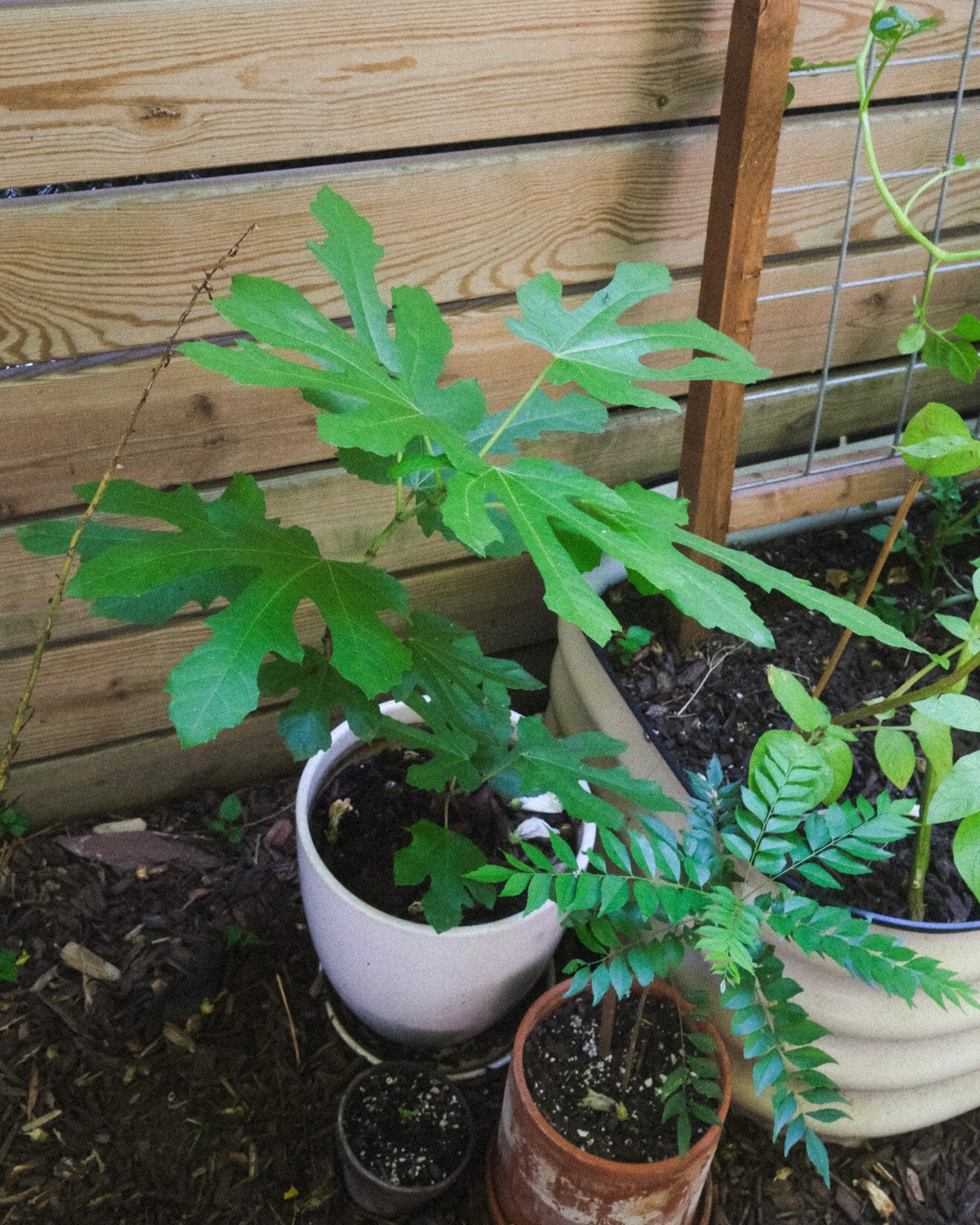
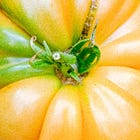
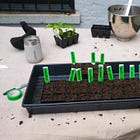
Your garden is lovely Kara! I love the variety you have and also the combination of raised beds with different sizes of pots. I should add more pots to our backyard! I feel the same about our tiny back yard with limited light. I stubbornly and desperately tried to plant flowers that should have full-sun and miserably failed for the last 3 years. That's why we have a plot at the community garden now so I can plan my cut flowers. I wonder if you can grow sweetpeas where you had your peas? I read that foxglove, canterbury bell and celosia can be planted in part shade - I love their more vertical shapes and would love to try next season. I plant sweet alyssum pretty much everywhere I have some small spaces like borders and edges and they are very easy. They look fun in pots too!
I too am living on a shady plot. Having come from a 4 acre property with south facing light, it’s a real adjustment. I’ve had a lot of issues with bolting because by the time things start to grow it gets too warm. Have you tried bush beans? I’ve had some success with those. Kudos though, this is a very impressive garden especially knowing your challenges with light.